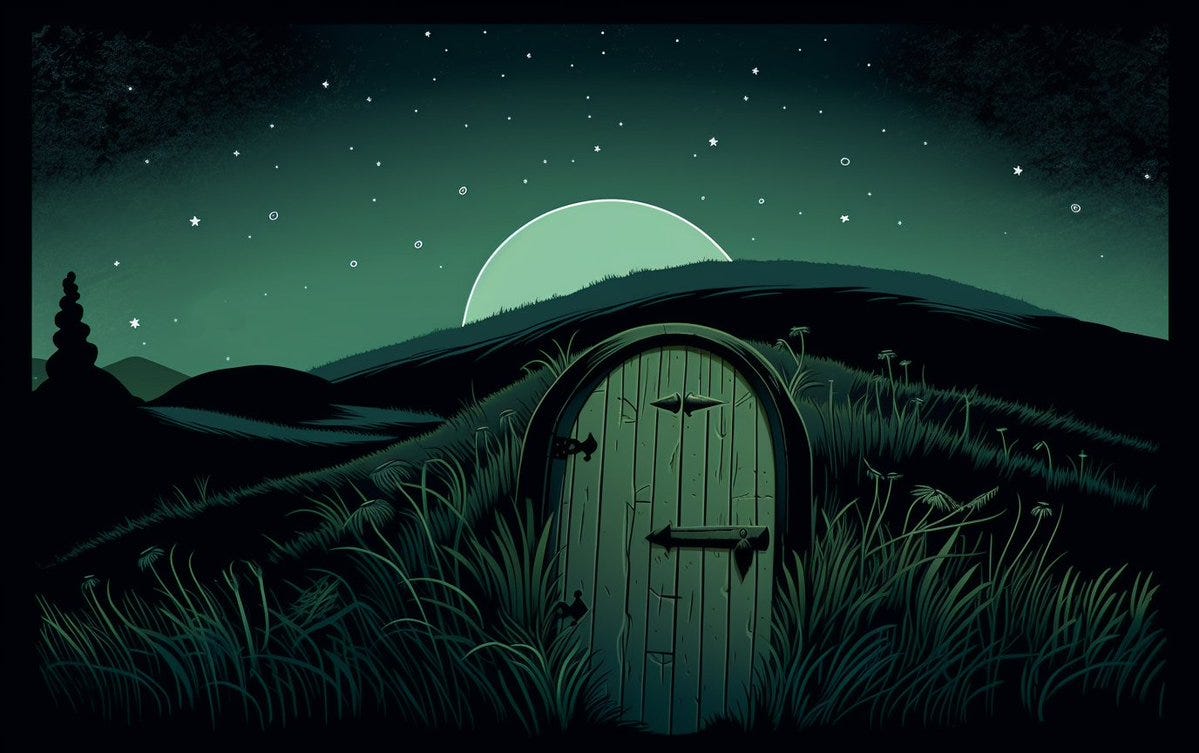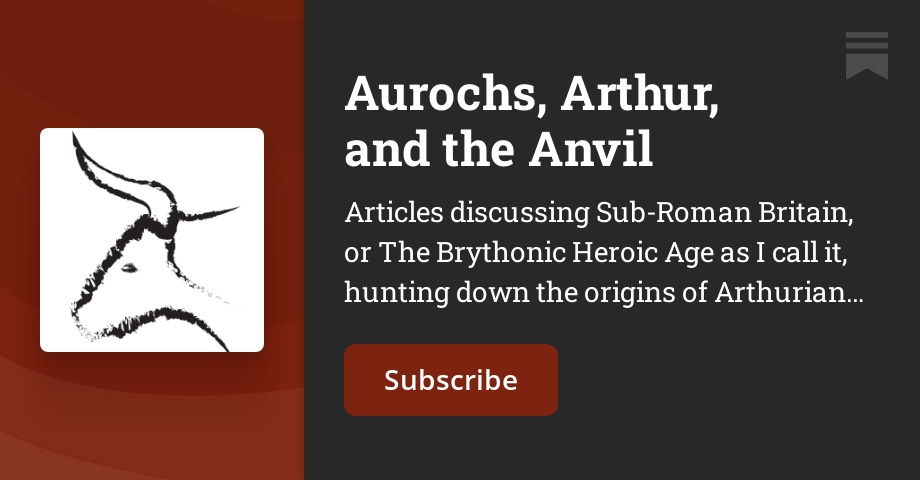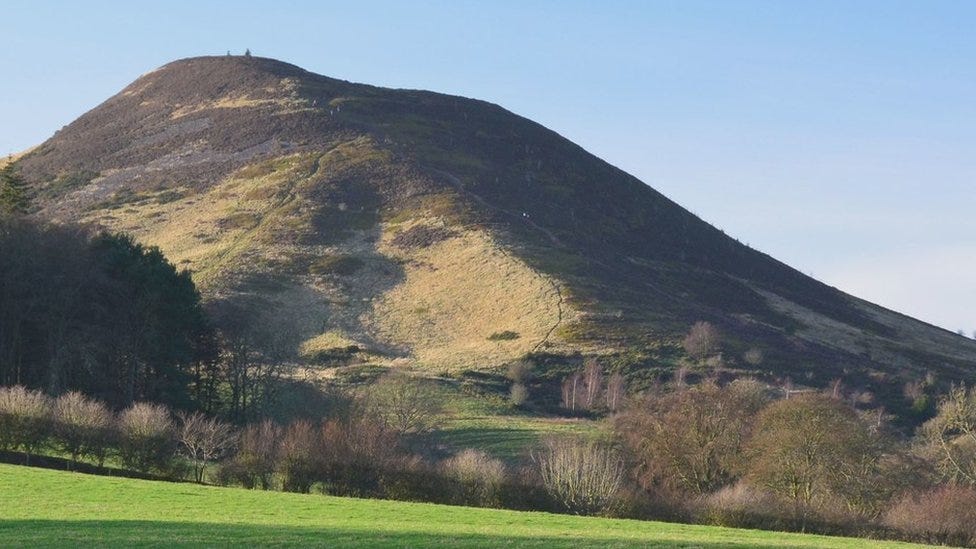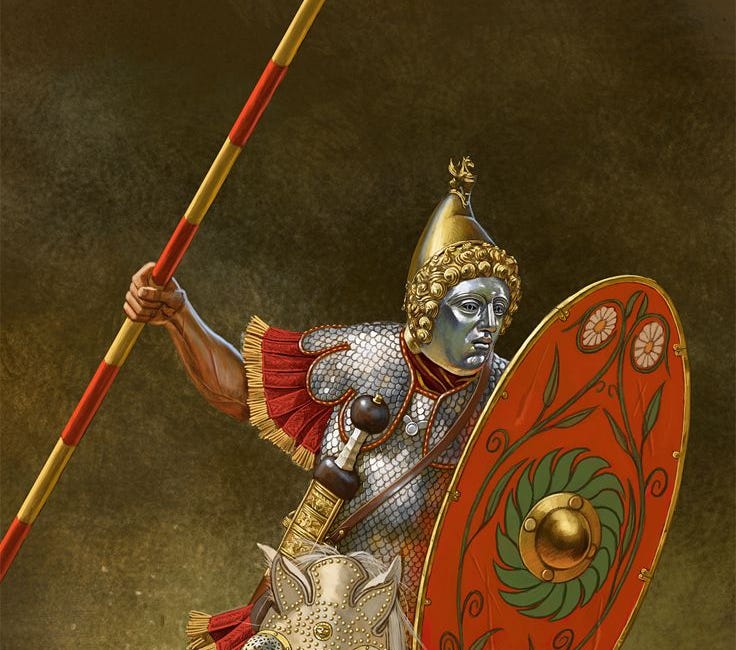Arthurian Tropes: The King Under the Mountain.
The Tale of Canobie Dick
That bids the charmed sleep of ages fly,
Rolls the long sound through Eildon’s caverns vast,
While each dark warrior rouses at the blast,
His horn, his falchion, grasps with mighty hand,
And peals proud Arthur’s march from Fairyland.
There is a strong tradition of folklore attaching King Arthur to Eildon Hills and the surrounding area. Much of this was popularized and revamped by late 18th and early 19th century poets, such as the excerpt from Leyden above, and from Sir Walter Scott.
Arthur is said to sleep beneath Eildon Hills with his warriors, a common motif across all of Britain. Sir Walter Scott recounts an embellished version of this tale, speaking of a horse trader named Canobie Dick.
After failing to sell his horses at the market, he encounters an old man in archaic clothing, who offers to buy the horses, and pays Dick in "ancient coin". This happens multiple times, until the old stranger invites Dick to his home. Dick is warned to keep his courage regardless of what he sees within the ancient stranger's home, and is led to a door hidden in the side of a hill that he had never seen before though he was very familiar with the area.
Within Dick sees stables, and a chamber full of mounted knights, sleeping. In their midst is the slumbering Arthur. There is an old oaken table, upon which sits an ancient sword and horn. He is told to take both, but the test lay in which he will take first. The old man is none other than Thomas of Ercildoun, also known as Thomas the Rhymer, a 13th century poet and prophet.
“He that shall sound that horn, and draw that sword shall, if his heart fail him not, be king over all broad Britain. But all depends on courage, and much on your taking the sword or horn first.”
Dick thinking taking the sword was a sign of aggression first grabs the horn, brings it to his lips and blows. The torchlit cavern comes alive with movement, horse and warrior stir, men draw swords, and cause a great clamor. Then a voice is heard.
"WOE TO THE COWARD, THAT EVER HE WAS BORN, WHO DID NOT DRAW THE SWORD BEFORE HE BLEW THE HORN"
Dick was swept from the cave by a great wind, right out of the door. He recounted his tale to the first shepherds he saw, and fell dead immediately after.
The King Under the Mountain
This is a famous story trope, and encompasses a massive amount of figures, from fictional to historical, and of course due to the fanciful nature of the story finding truth is unlikely. Frederick Barbarossa, Holy Roman Emperor from 1155 until his death in 1190 is said to sleep in a cave in the Kyffhäuser mountains, surrounded by his knights. Some legends say he sleeps under Mount Untersberg and will awaken when ravens fly close enough to the mountain. Other versions say that his beard has grown around the table that he sits at twice, and that when it wraps a third time the end of days will begin. Fionn mac Cumhaill (or Finn MacCool as he is elsewhere known) and his legendary warband the Fianna are said to sleep as well, waiting for the day the Dord Fiann (either a Horn or a War-Cry) to be sounded three times, upon which they will awaken at full strength ready to save Ireland. Queen Tamar the Great of Georgia is said to sleep in a gold wreathed coffin in a mountain, waiting to restore Georgia to it’s former glory. One of the most famous outside of Barbarossa is Ogier the Dane’s.
Ogier sleeps in Kronborg Castle, his beard grown so long as to touch the floor, awaiting Denmark’s greatest peril to rise again. Ogier is well known from as a Paladin of Charlemagne, who also gets associated with a similar tale, sleeping under Mount Untersberg, where Barbarossa was also said to rest.
Finding an origin for these is a difficult task, and variations of this legend are widespread, ranging from King David of Israel to Genghis Khan, and even similar stories being found in the Americas. The hope of a grand leader or hero returning is a strong urge, and it makes sense that this trope would be consistently repeated, and where else would be better for these fallen figures to recover their strength and await the hour of greatest need than nature’s own fortresses, mountains.
Memories of Places
One important thing to note, is that these heroes and kings are often interred in places significant to the actual figures in some way, usually associated with them in life, but sometimes culturally relevant to the writers. This brings us back to Arthur. Arthur is said to sleep under many hills in Britain, Craig-y-Ddinas in Glamorganshire is subject to a legend similar to the tale of Canobie Dick, as well as an army of his warriors sleeping in Snowdonia. A great number of these tales though take place in the North. From the aforementioned Eildon Hills, to a version in Sewingshields near the wall, as well as Freebrough Hill in the North York Moors, and another variant at Richmond Castle, in North Yorkshire. Interestingly all places that Arthwys ap Mar likely held sway over during his reign. The story and the burial places may be fictional, but the association may be real. Taking a look at these northern sites in context is interesting, especially considering how tightly they cluster around Yorkshire and the Wall.
Looking at Eildon specifically, an area that seems out of place compared to Freebrough Hill and Richmond Castle, and doesn’t immediately seem to implicate Arthwys, one of the most famous kings of this area was the late 6th early 7th century king Cadrod Calchfynydd or Cadrod ap Cynwyd ap Cynfelyn ap Arthwys. The exact whereabouts of Calchfynydd itself are unknown, and there are varying theories. Some place it in the Chilterns, but others have made convincing cases that it was centered on Kelso in the borders. With the ever growing Saxon presence it would be hard to believe that his grandfather Cynfelyn carved out such a vast kingdom so far south of his family's territory
This makes the northern evidence ever more compelling, such as the early name of Kelso, Calkou or Calchou, a memory of the Chalk Cliffs Calchfynydd (Chalk Mountain) was named for. Calchfynydd and it’s likely neighbor Caer Wenddoleu likely came about as buffer kingdoms set up late in Arthwys ap Mar’s life, shielding himself and his kin from their begrudged northern sometimes allies, sometimes enemies, the Gododdin, the Picts, and Alt Clut. Under Brythonic practice of gavelkind inheritance a father’s territory is split, and yet Arthwys’ kingdom of Ebrauc (York) was not split, but went entirely to his son Eliffer. We know that his grandchildren and great-grandchildren ruled these two other kingdoms Calchfynydd and Caer Wenddoleu in a time when Brythonic kingdoms were losing ground in significant portions, so it is reasonable to surmise that these were buffer states Arthwys himself set up, Calcfynydd for Cadrods grandfather Cynfelyn, and Caer Wenddoleu for Arthwy’s son Ceidio.
Arthwys' is a strong contender for the initial inspiration for the later King Arthur of legend, and if Nennius' battle list is indeed a list of battles fought by Arthwys then there may be a deeper reason for Eildon's Arthurian association.
Quite a few of these battles when mapped to their most likely places appear in the North, and a few are situated very close to the borders between Bryneich and their neighbors, Alt Clut, and Gododdin. You can read on these theories here.
Arthur's Twelve Battles | Aurochs, Arthur, and the Anvil | SubstackAn analysis of potential sites of King Arthur's twelve battles recounted by Nennius. Click to read Aurochs, Arthur, and the Anvil, a Substack publication with thousands of readers.https://aurochs.substack.com/s/arthurs-twelve-battles
Arthwys very well could have operated from this area in his early career, much as Allister Moffat discusses in his book 'Arthur and the Lost Kingdoms'. I discuss Brythonic use of heavy cavalry here as well. Without harder evidence of course we can't draw heavier conclusions here, however maybe there is reason behind the later legendary tales, instead of just hopeful local folklore. Maybe an Arthur did ride out from Eildon, or Roxburgh? Might it be even that Arthwys was interred underneath Freebrough Hill? No telling for sure, and my friend
has another theory that you should check out here.Special Guest Feature @p5ych0p0mp: Part 3: Some Lesser Known Monuments to Arthur and Owain
Part 3: Some Lesser Known Monuments to Arthur and Owain The setting of many medieval Arthurian romances was inspired by the real locations of events in the British Heroic Age. These historical events were often projected onto the place names of the landscape of the Hen Ogledd (Old…
As always thank you for reading, and I hope that if you enjoyed this you will subscribe and share, I will be finishing up a look at the idea of the later Arthur as a composite figure (which he 100% is) as well as an exciting new series looking at portrayals of Arthur in various forms of Media!









